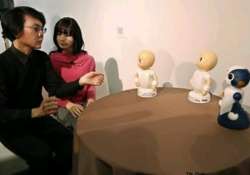Japan to sell talking robots that won't try to make sense
Tokyo: The scientist behind a new talking robot in Japan says people should stop expecting robots to understand them, and instead try to chime in with robotic conversations.Hiroshi Ishiguro's 28-centimer (11-inch) tall button-eyed Sota, which

Tokyo: The scientist behind a new talking robot in Japan says people should stop expecting robots to understand them, and instead try to chime in with robotic conversations.
Hiroshi Ishiguro's 28-centimer (11-inch) tall button-eyed Sota, which stands for "social talker," is programmed to mainly talk with a fellow robot, and won't be trying too hard to understand human speech — the major, and often frustrating, drawback of companion robots.
Sota, shown to reporters at a Tokyo museum Tuesday, goes on sale in July at under 100,000 yen ($850) each. To fully enjoy its features, one would have to buy at least two of them, although people can buy just one.
"Don't stop at just two. Please buy three or four," said Ishiguro, a professor at Osaka University, who has previously shown a variety of robots that look eerily human, including one that's his double.
Ishiguro also demonstrated a more elaborate robot CommU, which stands for communication unity. It will cost five times as much as Sota.
The news conference to introduce Sota and CommU was led by two other humanoids, which appeared to talk with the two newest additions to Japan's robot pantheon.
Robot maker Vstone, which simplified Ishiguro's research to come up with commercial products, expects to sell 3,000 Sota robots in the first year, mostly to businesses. They could be used for tasks such as drawing attention to products on display.
Japan is a leading maker of robots, and its repertoire has ranged from industrial robots to whimsical toys.
Internet and telecommunications company Softbank Corp. will start selling Pepper, a humanoid it claims is designed to read human emotions, in Japan next month for 198,000 yen ($1,700), possibly heralding the era of everyday robots here.
Ishiguro said the idea behind Sota and CommU was similar to watching chattering children. An adult joining such a conversation would have low expectations and be engaging in dialogue for the fun, he said.
CommU is designed to make eye contact with rolling eyeballs, a feature Ishiguro believes is important to make conversations feel real.
In a demonstration, one CommU said to another CommU, "Do you know Denmark?"
It replied: "I love Denmark," to which the first said, "I love Denmark, too."
Ishiguro insists the robots can do more than just agree with each other, and can be programmed to carry on various kinds of conversations, including confrontational chatter.
But the main point is that people should stop expecting robots to live up to human expectations or merely do useful chores.
"Voice recognition has always been very difficult for robots," Ishiguro said. "Human beings should instead adjust to what robots can do."